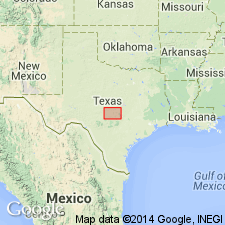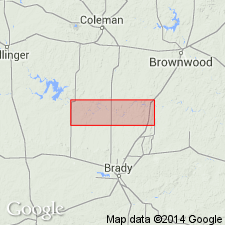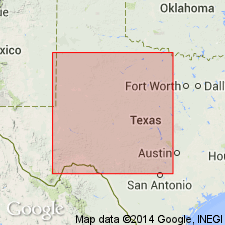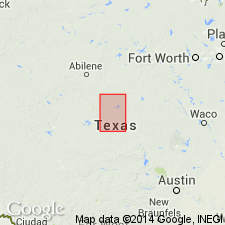
- Usage in publication:
-
- Coon Mountain bed
- Modifications:
-
- Original reference
- Dominant lithology:
-
- Sandstone
- Conglomerate
- AAPG geologic province:
-
- Bend arch
Summary:
Pg. 387, 417. Coon Mountain bed in Cisco division. Sandstone and conglomerate, 0 to 75 feet thick. Member of Cisco division (Cisco is 2nd from top of 5 Carboniferous divisions of Cummins, 1891). Underlies Stockwether bed and overlies Camp Creek bed. Age is Pennsylvanian.
[Named from Coon Mountain, Brown Co., Colorado River region, central TX.] Best exposures from Coon Mountain southward to Gulf, Colorado and Santa Fe RR, Brown and Coleman Cos., Colorado River region, central TX.
Source: US geologic names lexicon (USGS Bull. 896, p. 512); supplemental information from GNU records (USGS DDS-6; Denver GNULEX).

- Usage in publication:
-
- Coon Mountain bed
- Modifications:
-
- Revised
- AAPG geologic province:
-
- Bend arch
Summary:
Footnote on p. 172 and charts. Detailed mapping of western part of Brown County has shown that Coon Mountain sandstone bed (No. 11 of Drake's section) is largely Cretaceous sands overlapping several Pennsylvanian beds.
Named from Coon Mountain, Brown Co., Colorado River region, central TX.
Source: US geologic names lexicon (USGS Bull. 896, p. 512).

- Usage in publication:
-
- Coon Mountain sandstone
- Modifications:
-
- Overview
- AAPG geologic province:
-
- Bend arch
Summary:
Pg. 103. Recognized Coon Mountain sandstone of Drake as underlying Stockwether limestone and overlying Camp Creek shale. [Age is Pennsylvanian.]
Source: US geologic names lexicon (USGS Bull. 896, p. 512).

- Usage in publication:
-
- Coon Mountain sandstone
- Modifications:
-
- Not used
- AAPG geologic province:
-
- Bend arch
Summary:
Ignored Coon Mountain sandstone, and redefined Camp Creek shale member to include all beds in McCulloch County beneath Stockwether limestone and above Saddle Creek shale. [Age is Pennsylvanian.]
Source: US geologic names lexicon (USGS Bull. 896, p. 512).

- Usage in publication:
-
- Coon Mountain sandstone member*
- Modifications:
-
- Revised
- Adopted
- AAPG geologic province:
-
- Bend arch
Summary:
Coon Mountain sandstone member of Pueblo formation underlies Stockwether limestone and overlies Camp Creek shale member.
[This is adopted definition of the USGS.]
Source: US geologic names lexicon (USGS Bull. 896, p. 512).

- Usage in publication:
-
- Coon Mountain sandstone member
- Modifications:
-
- Revised
- Age modified
- AAPG geologic province:
-
- Bend arch
Summary:
Pg. 66 (fig. 1). Coon Mountain sandstone member of Stockwether formation of Pueblo group. Reallocated to Stockwether, which is here given formational status in Pueblo group (redefined) and assigned to the Permian [Early Permian (Wolfcamp)].
Source: US geologic names lexicon (USGS Bull. 1200, p. 927-928).

- Usage in publication:
-
- Coon Mountain sandstone member*
- Modifications:
-
- Areal extent
- AAPG geologic province:
-
- Bend arch
Summary:
Pg. 75, 76. Coon Mountain sandstone member of Pueblo formation. Member of Pueblo formation in report on Brown and Coleman Counties where it is placed above Camp Creek shale member and below Stockwether limestone member. In northern Brown County, extensive channel erosion has removed Saddle Creek limestone member in many places, especially over wide area on Coon Mountain. In places, channel erosion has cut down to within about 50 feet of Chaffin limestone member of Thrifty formation. The sandstone and conglomerate deposited in these channels was called Coon Mountain bed by Drake (1893). Plummer and Moore considered it of Cretaceous age. As the unit was not extensively exposed in area mapped by Moore (1949, USGS Oil and Gas Inv. Prelim. Map 80), he did not use the name. Exact relations of Coon Mountain sandstone member to beds surrounding it are only partially known. The thick body may be a complex of two or more channels, the later one or ones superposed on the earlier in the outcrop area. The member is tentatively placed in the section where Drake placed it until future detailed work explains its relations more exactly. [Age is Early Permian (Wolfcamp).]
Source: US geologic names lexicon (USGS Bull. 1200, p. 927-928).
For more information, please contact Nancy Stamm, Geologic Names Committee Secretary.
Asterisk (*) indicates published by U.S. Geological Survey authors.
"No current usage" (†) implies that a name has been abandoned or has fallen into disuse. Former usage and, if known, replacement name given in parentheses ( ).
Slash (/) indicates name conflicts with nomenclatural guidelines (CSN, 1933; ACSN, 1961, 1970; NACSN, 1983, 2005, 2021). May be explained within brackets ([ ]).

